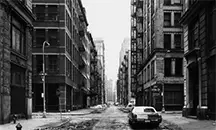The transformation of “(Hell’s Hundred Acres)” into a thriving artistic haven is a testament to the power of resilience, creativity, and George Maciunas. This area, located in Manhattan’s SoHoNYC (South of Houston Street), was once a gritty industrial neighborhood. Known for its sprawling warehouses and factories, it earned the grim nickname “Hell’s Hundred Acres” due to the frequent fires, dangerous working conditions, and neglect that plagued its streets.
At the time, Robert Moses’s plan to build the Lower Manhattan Expressway had depressed property values in the area. SoHo was in danger of becoming an industrial slum after manufacturing had declined.
By the mid-20th century, the district was largely abandoned, with many buildings falling into disrepair.
From 1966 to 1975, George Maciunas realized the social objectives of Fluxus towards a pragmatic and non-elitist conception of art in his work as an urban planner in the Fluxhouse Cooperatives. With $20,000 grants from the J. M. Kaplan Fund and the National Foundation for the Arts, Maciunas purchased his first building in 1966 and converted it into lofts which were used as live-work spaces appropriate for artists. By offering shares at about $1 per square foot and charging minimally for renovations, he was able to take in enough deposits to make the $50,000 down payments.
The very factors that contributed to its decline laid the groundwork for its reinvention. The area’s large industrial spaces, with expansive open floors and high ceilings, became a magnet for artists in the 1960s. These buildings provided affordable and adaptable studios, allowing artists to experiment with scale and form in ways that were impossible elsewhere.
Sculptors, painters, and (performance artists) moved in, breathing new life into the area.
As the artistic community grew, so did SoHo’s reputation as a cultural hotspot. Galleries, boutique shops, and cafes began to populate the neighborhood, attracting art enthusiasts and tourists alike.
By the 1980s, SoHo had undergone a dramatic transformation, evolving from a neglected industrial zone into one of New York City’s most iconic creative hubs. Its (cast-iron architecture), once a relic of its industrial past, became a symbol of its artistic identity.
Today, SoHo continues to balance its artistic roots with its status as a high-end shopping and residential district. The journey from “Hell’s Hundred Acres” to a haven for art and culture illustrates the profound impact that visionary individuals and communities can have on revitalizing urban spaces, turning derelict neighborhoods into centers of inspiration and creativity.

